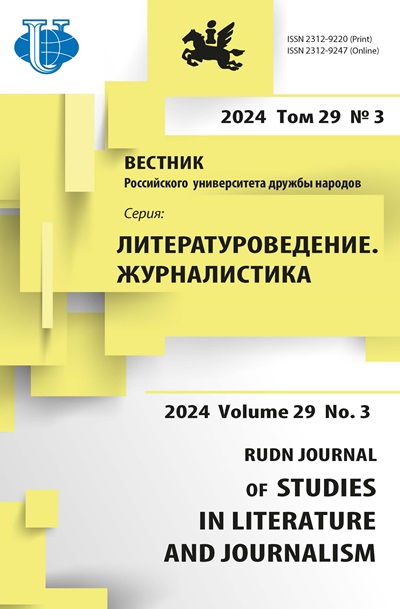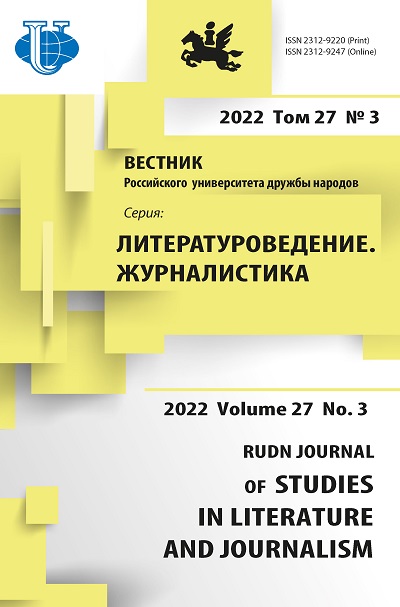Позиционирование как дискурсивная стратегия
- Авторы: Осокин А.А.1, Цзинь Х.2
-
Учреждения:
- Российский университет дружбы народов
- Сианьский международный университет
- Выпуск: Том 27, № 3 (2022)
- Страницы: 567-572
- Раздел: Журналистика
- URL: https://journals.rudn.ru/literary-criticism/article/view/32310
- DOI: https://doi.org/10.22363/2312-9220-2022-27-3-567-572
Цитировать
Полный текст
Аннотация
Предпринята попытка с точки зрения медиакоммуникационного подхода (основанного на теории филологии и теории коммуникации) определить связь между позиционированием и дискурсом. Предметом исследования выступает позиционирование как дискурсивная стратегия. Используется комплекс методов: синтез, сопоставительный анализ, интерпретативный анализ. С одной стороны, изучение позиционирования как дискурсивной практики предполагает анализ дискурса; с другой стороны, обозначение позиционирования как дискурсивной стратегии фокусируется на инструментах достижения цели (коммуникативных ходах, используемых во время позиционирования). Предлагается теоретическое обоснование позиционирования как дискурсивной стратегии, в основе которой заложен дискурс - речь, «погруженная в жизнь» (термин Н.Д. Арутюновой), выступающая, согласно авторской интерпретации, в роли средства коммуникации. Делается вывод, что позиционирование одновременно представляет собой коммуникативное воздействие, направленное на сознание принимающей стороны, и манипулятивное явление, реализация которого происходит посредством влияния на связи, имеющиеся в сознании индивида. В свою очередь актор, оперирующий позиционированием, способен достичь множества поставленных целей в ходе реализации коммуникативного акта.
Ключевые слова
Об авторах
Артем Алексеевич Осокин
Российский университет дружбы народов
Автор, ответственный за переписку.
Email: osokincontact@gmail.com
ORCID iD: 0000-0002-1625-2355
соискатель кафедры массовых коммуникаций
Российская Федерация, 117198, Москва, ул. Миклухо-Маклая, д. 10, корп. 2Хань Цзинь
Сианьский международный университет
Email: jin.han2017@yandex.ru
ORCID iD: 0000-0001-8001-7029
преподаватель, факультет журналистики и коммуникации
Китайская Народная Республика, 710077, Сиань, ул. Юйдоу, д. 18Список литературы
- Алгави Л.О., Волкова И.И., Кадырова Ш.Н., Расторгуева Н.Е. Особенности нарратива «Дело Скрипалей» в телепрограмме «Вести недели»: анализ сюжетной схемы // Вестник Московского университета. Серия 10: Журналистика. 2019. № 3. С. 62-83. http://doi.org/10.30547/vestnik.journ.3.2019.6283
- Арутюнова Н.Д. Дискурс // Языкознание. Большой энциклопедический словарь. М.: Большая Российская энциклопедия, 1998. С. 136-137
- Бенвенист Э. Общая лингвистика. М.: Прогресс, 1974. 448 с
- Волкова И.И., Ашур Х.Ю.Д. Медиаобраз Иордании в интернет-СМИ Рунета: особенности «неперсонификации» // Вопросы теории и практики журналистики. 2021. Т. 10. № 1. С. 39-50. http://doi.org/10.17150/2308-6203.2021.10(1).39-50
- Ефанов А.А. Общество во власти медиапроцессов. М.: ИНФРА-М, 2021. 189 с.
- Траут Дж., Райс Э. Позиционирование: битва за узнаваемость. СПб.: Питер, 2001. 256 с.
- Филлипс Л.Дж., Йоргенсен М.В. Дискурс-анализ. Теория и метод. Харьков: Гуманитарный цeнтp, 2008. 352 с.
- Якобсон Р.О. Лингвистика и поэтика // Структурализм: «за» и «против». М.: Прогресс, 1975. С. 5-11.
- Kozhemyakin E. Mediatised home: Using semiotic repertoires in online workplace communications // Communication Today. 2021. Vol. 12. No. 2. Pp. 58-66.
- Muzykant V.L., Muqsith V.A., Burdovskaya E.Y., Palagina I.V., Barabash V.V., Volkova I.I. Contemporary transportation applications as new forms of social construction technology // WorldS4 2021: Proceedings of the 2021 5th World Conference on Smart Trends in Systems Security and Sustainability. London: Institute of Electrical and Electronics Engineers Inc., 2021. Pp. 6-11. http://doi.org/10.1109/WorldS451998.2021.9514063
- Yefanov A., Tomin V. The significance of protest mood in forming a developed civil society in Russia // Russian Politics. 2022. Vol. 7. No. 1. Pp. 147-165. http://doi.org/10.30965/24518921-00604015
















